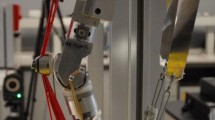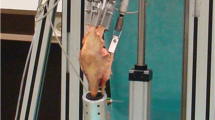Abstract
Purpose
Reproducing the femoral rollback through specially designed mechanism in knee implants is required to achieve full knee function in total knee arthroplasty. Most contemporary implants use cam/post mechanism to replace the function of Posterior Cruciate Ligament. This study was aimed to determine the most appropriate cam and post designs to produce normal femoral rollback of the knee.
Methods
Three different cams (triangle, ellipse, and circle) and three different posts (straight, convex, concave) geometries were considered in this study and were analysed using kinematic analyses. Femoral rollback did not occur until reaching 50° of knee flexion. Beyond this angle, two of the nine combinations demonstrate poor knee flexion and were eliminated from the study.
Results
The combination of circle cam with concave post, straight post and convex post showed 15.6, 15.9 and 16.1 mm posterior translation of the femur, respectively. The use of ellipse cam with convex post and straight post demonstrated a 15.3 and 14.9 mm femoral rollback, whilst the combination of triangle cam with convex post and straight post showed 16.1 and 15.8 mm femoral rollback, respectively.
Conclusion
The present study demonstrates that the use of circle cam and convex post created the best femoral rollback effect which in turn produces the highest amount of knee flexion. The findings of the study suggest that if the design is applied for knee implants, superior knee flexion may be possible for future patients.
Level of evidence
IV.









Similar content being viewed by others
References
Akasaki Y, Matsuda S, Shimoto T, Miura H, Higaki H, Iwamoto Y (2008) Contact stress analysis of the conforming post-cam mechanism in posterior-stabilized total knee arthroplasty. J Arthroplasty 23:736–743
Argenson JN, Scuderi GR, Komistek RD, Scott WN, Kelly MA, Aubaniac JM (2005) In vivo kinematic evaluation and design considerations related to high flexion in total knee arthroplasty. J Biomech 38:277–284
Banks S, Bellemans J, Nozaki H, Whiteside LA, Harman M, Hodge WA (2003) Knee motions during maximum flexion in fixed and mobile-bearing arthroplasties. Clin Orthop Relat Res 410:131–138
Bin SI, Nam TS (2007) Early results of high-flex total knee arthroplasty: comparison study at 1 year after surgery. Knee Surg Sports Traumatol Arthrosc 15:350–355
de Jong RJ, Heesterbeek PJ, Wymenga AB (2010) A new measurement technique for the tibiofemoral contact point in normal knees and knees with TKR. Knee Surg Sports Traumatol Arthrosc 18:388–393
Dennis DA, Komistek RD, Mahfouz MR, Haas BD, Stiehl JB (2003) Multicenter determination of in vivo kinematics after total knee arthroplasty. Clin Orthop Relat Res 416:37–57
Dennis DA, Komistek RD, Mahfouz MR (2003) In vivo fluoroscopic analysis of fixed-bearing total knee replacements. Clin Orthop Relat Res 410:114–130
Emodi GJ, Callaghan JJ, Pedersen DR, Brown TD (1999) Posterior cruciate ligament function following total knee arthroplasty: the effect of joint line elevation. Iowa Orthop J 19:82–92
Godest AC, de Cloke CS, Taylor M, Gregson PJ, Keane AJ, Sathasivan S et al (2003) A computational model for the prediction of total knee replacement kinematics in the sagittal plane. J Biomech 33:435–442
Hartford JM, Banit D, Hall K, Kaufer H (2001) Radiographic analysis of low contact stress meniscal bearing total knee replacements. J Bone Joint Surg Am 83-A:229–234
Hefzy MS, Kelly BP, Cooke TD (1998) Kinematics of the knee joint in deep flexion: a radiographic assessment. Med Eng Phys 20:302–307
Kim YH, Sohn KS, Kim JS (2005) Range of motion of standard and high-flexion posterior stabilized total knee prostheses. A prospective, randomized study. J Bone Joint Surg Am 87:1470–1475
Li G, Most E, Sultan PG, Schule S, Zayontz S, Park SE et al (2004) Knee kinematics with a high-flexion posterior stabilized total knee prosthesis: an in vitro robotic experimental investigation. J Bone Joint Surg Am 86-A:1721–1729
Limbert G, Middleton J (2006) A constitutive model of the posterior cruciate ligament. Med Eng Phys 28:99–113
Lin KL, Huang CH, Liu YL, Chen WC, Chang TW, Yang CT et al (2011) Influence of post-cam design of posterior stabilized knee prosthesis on tibiofemoral motion during high knee flexion. Clin Biomech 26:847–852
Lionberger DR, Eggers MD, Brewer KE, Fang L (2012) Improved knee flexion following high-flexion total knee arthroplasty. J Orthop Surg Res 7:22
Lu TW, Tsai TY, Kuo MY, Hsu HC, Chen HL (2008) In vivo three-dimensional kinematics of the normal knee during active extension under unloaded and loaded conditions using single-plane fluoroscopy. Med Eng Phys 30:1004–1012
Maruyama S, Yoshiya S, Matsui N, Kuroda R, Kurosaka M (2004) Functional comparison of posterior cruciate-retaining versus posterior stabilized total knee arthroplasty. J Arthroplasty 19:349–353
Most E, Li G, Sultan PG, Park SE, Rubash HE (2005) Kinematic analysis of conventional and high-flexion cruciate-retaining total knee arthroplasties: an in vitro investigation. J Arthroplasty 20:529–535
Nakagawa S, Johal P, Pinskerova V, Komatsu T, Sosna A, Williams A et al (2004) The posterior cruciate ligament during flexion of the normal knee. J Bone Joint Surg Br 86:450–456
Padua R, Ceccarelli E, Bondi R, Campi A, Padua L (2007) Range of motion correlates with patient perception of TKA outcome. Clin Orthop Relat Res 460:174–177
Pandit H, van Duren BH, Price M, Tilley S, Gill HS, Thomas NP, Murray DW (2013) Constraints in posterior-stabilised TKA kinematics: a comparison of two generations of an implant. Knee Surg Sports Traumatol Arthrosc 21(12):2800–2809
Pereira GC, Walsh M, Wasserman B, Banks S, Jaffe WL, Di Cesare PE (2008) Kinematics of the stiff total knee arthroplasty. J Arthroplasty 23:894–901
Pritchett JW (2004) Patient preferences in knee prostheses. J Bone Joint Surg Br 86:979–982
Ranawat CS (2003) Design may be counterproductive for optimizing flexion after TKR. Clin Orthop Relat Res 416:174–176
Robertsson O, Dunbar MJ (2001) Patient satisfaction compared with general health and disease-specific questionnaires in knee arthroplasty patients. J Arthroplasty 16:476–482
Tamaki M, Tomita T, Watanabe T, Yamazaki T, Yoshikawa H, Sugamoto K (2009) In vivo kinematic analysis of a high-flexion, posterior-stabilized, mobile-bearing knee prosthesis in deep knee bending motion. J Arthroplasty 24:972–978
van Duren BH, Pandit H, Beard DJ, Zavatsky AB, Gallagher JA, Thomas NP et al (2007) How effective are added constraints in improving TKR kinematics? J Biomech 40(1):S31–S37
Walker PS, Blunn GW, Broome DR, Perry J, Watkins A, Sathasivam S et al (1997) A knee simulating machine for performance evaluation of total knee replacements. J Biomech 30:83–89
Walker PS, Sussman-Fort JM, Yildirim G, Boyer J (2009) Design features of total knees for achieving normal knee motion characteristics. J Arthroplasty 24:475–483
Weiss JM, Noble PC, Conditt MA, Kohl HW, Roberts S, Cook KF et al (2002) What functional activities are important to patients with knee replacements? Clin Orthop Relat Res 404:172–188
Wilson DR, Feikes JD, O’Connor JJ (1998) Ligaments and articular contact guide passive knee flexion. J Biomech 31:1127–1136
Yu CH, Walker PS, Dewar ME (2001) The effect of design variables of condylar total knees on the joint forces in step climbing based on a computer model. J Biomech 34:1011–1021
Zelle J, Heesterbeek PJ, De Waal Malefijt M, Verdonschot N (2010) Numerical analysis of variations in posterior cruciate ligament properties and balancing techniques on total knee arthroplasty loading. Med Eng Phys 32:700–707
Zelle J, Van der Zanden AC, De Waal Malefijt M, Verdonschot N (2009) Biomechanical analysis of posterior cruciate ligament retaining high-flexion total knee arthroplasty. Clin Biomech 24:842–849
Zingde SM, Leszko F, Sharma A, Mahfouz MR, Komistek RD, Dennis DA (2014) In vivo determination of cam-post engagement in fixed and mobile-bearing TKA. Clin Orthop Relat Res 472(1):254–262
Acknowledgments
This study has been supported by eScience Fund research grant from the Ministry of Science, Technology and Innovation Malaysia and FRGS research grant from the Ministry of Higher Education Malaysia. Authors also acknowledge financial support from Universiti Teknologi Malaysia RU Grant. More than one of the authors of this paper is supported by the University of Malaya HIR-MoE (Reference number - UM.C/625/1/HIR/ MOHE/MED/04, Account number - E000003-20001) research grant initiative. All authors have no competing interests and the nature of work did not require any ethical approval.
Author information
Authors and Affiliations
Corresponding author
Rights and permissions
About this article
Cite this article
Fallahiarezoodar, A., Abdul Kadir, M.R., Alizadeh, M. et al. Geometric variable designs of cam/post mechanisms influence the kinematics of knee implants. Knee Surg Sports Traumatol Arthrosc 22, 3019–3027 (2014). https://doi.org/10.1007/s00167-014-3227-7
Received:
Accepted:
Published:
Issue Date:
DOI: https://doi.org/10.1007/s00167-014-3227-7




